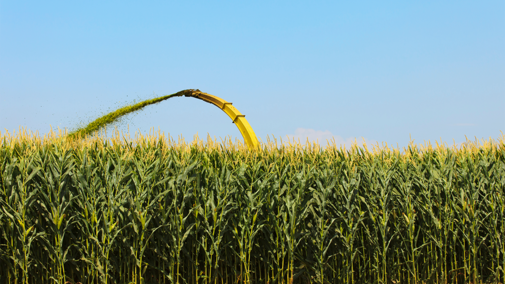Corn Silage Harvest Adjustment
Silage harvest for fully irrigated full-season corn usually begins 45 days or 800 growing degree days (GDDs) after the tassel/silking growth stage. However, corn maturity can hasten due to drought, heat stress and shorter-season hybrid breeding. Therefore, ear kernel milk line development and accumulated GDDs may be better predictors for timing silage harvest than following a calendar, especially for drought-impacted corn.
Accurately assessing whole plant moisture is key to proper silage pile fermentation and tight packing. If silage is too dry, then packing is difficult and may allow oxygen into the pile, causing overheating, mold/yeast/bad microbe growth, and spoilage. When the silage moisture content is too high, piles can weep with valuable energy and nutrients flowing out as a loss from the pile. Also, damaging clostridia bacteria colonies can grow when silage is too wet. So, -
Another factor to consider for silage chopping is milk line (a corn kernel starch content indicator). Starch is one of the most energy dense feed components, so silage that contains higher amounts of starch will be higher energy overall. The further down the kernel milk line is established, the more starch content has been stored in the kernel.
However, plant moisture and milk line may not be directly correlated and may vary among hybrids. While these development factors trend in the same direction, the moisture content can still vary. For example, corn that is 55% moisture and ¼ milk may be 65% moisture at the same ¼ milk the next field over.
Corn silage is a great feed resource that can benefit from moisture content monitoring at harvest. Target harvest silage at 65-70% moisture content for best results. Use the ear kernel milk line (closer to the cob means more starch and higher energy silage) to find your ideal harvest window based on your hybrids.
Adding Grass to Thinning Alfalfa
Do you have a thinning and low-producing alfalfa stand but are not quite ready to do a complete reseeding? These stands can be rejuvenated by interseeding grasses to increase hay production in subsequent years or to convert them to pasture.
Most alfalfa fields start to lose stand and production potential after cutting hay for several years. Orchardgrass is the grass most commonly interseeded into alfalfa, but other grasses like endophyte-free tall fescue, smooth or meadow brome, festulolium and wheatgrasses also can be used. If the field will be used as pasture, a mixture of several grasses may be best since it adds diversity to your animals' diet.
Whether irrigated or dryland, interseeding after a mid-August to early September hay harvest can be excellent timing. There is always some risk for dryland fields because several rains will be needed to start the new grass seedlings. The seeding should be done as sone as that August or early September harvest is complete. If your alfalfa is relatively thick, you probably will need to take another cutting in about four weeks, or as soon as the alfalfa starts to form a full canopy. This allows sunlight to continue to reach new grass seedlings below the alfalfa.
The seeding rate of the grasses will vary depending on the species that is used and how thick the existing alfalfa is. With orchardgrass for example, as little as 3 lb./acre might be adequate in a relatively thick alfalfa stand or up to 6 lb./acre in a very thin alfalfa stand.
Next spring you will need to judge how well established the new grasses have become. If they seem a little weak, cut hay early to open the canopy for better light penetration.
Inoculants for Corn Silage
Corn silage harvest success rests on proper harvest, packing and storage practices. When we need a boost, adding an inoculant at harvest time can help improve fermentation and storage, but we need to know what products to use to get the best result.
Silage inoculants are simply bacterial cultures that help manage pH in the pile by converting sugars to acids which reduce molds, fungi and unwanted bacteria such as clostridia.
When selecting an inoculant, the first step is deciding if upfront fermentation or pile stability are needed, or maybe both. Upfront fermentation helps if most of our issues center around harvest and packing. If problems are more centered on storage and feed out, stability is where we should spend our money. Sometimes, a mix of both are needed.
Inoculants primarily reduce storage losses. Silages that contain homolactic acid bacteria such as Lactobacillus plantarum help fermentation start and end quicker by dropping the pH fast. This allows more silage to remain for feeding. Other inoculants, like heterolactic acid bacteria Lactobacillius buchneri, can improve aerobic stability by reducing spoilage losses when silage is re-exposed to air. These bacteria are especially useful at reducing spoilage on the face of bunker silos if the face is too wide to keep fresh or if producers take out several days’ worth of feed from the pile at one time.
The purpose of inoculants is not to fix a train wreck or improve a perfect silage year, but they can help when things aren’t ideal. Inoculants can be used as an insurance policy to reduce the risk of spoilage and maintain quality.

